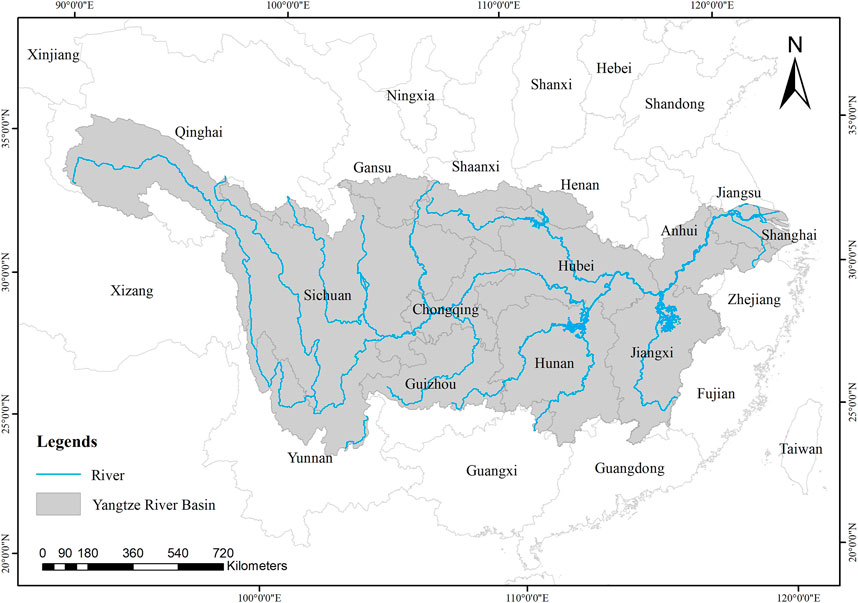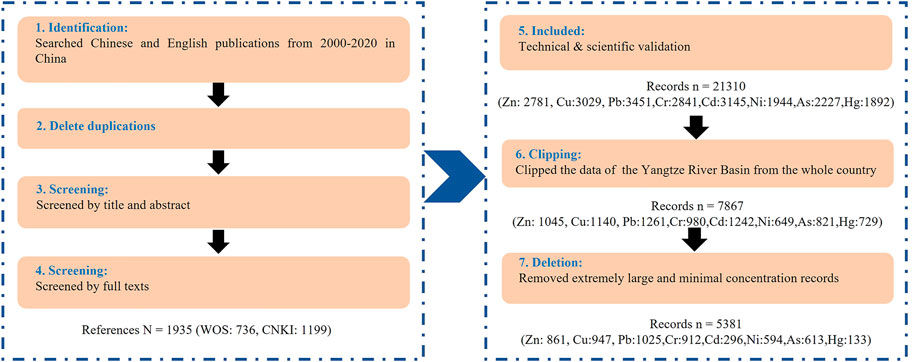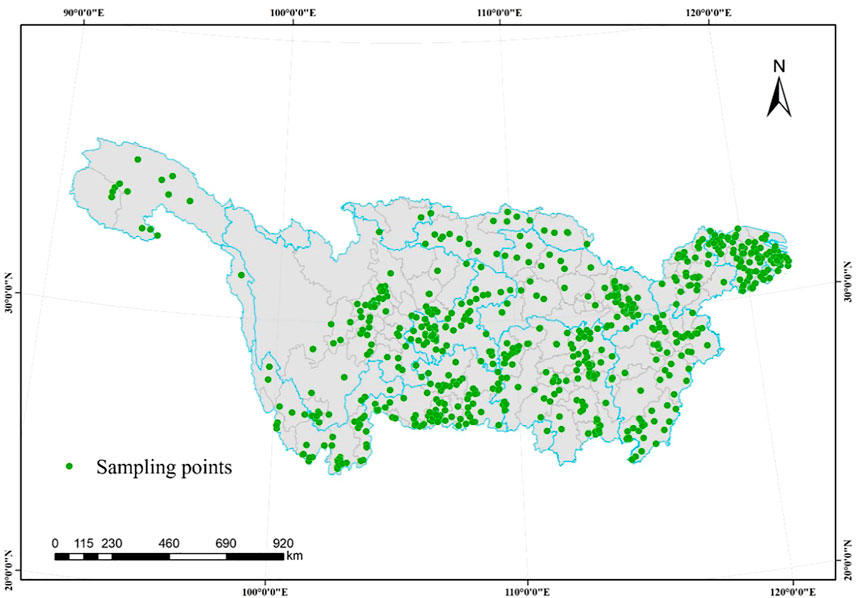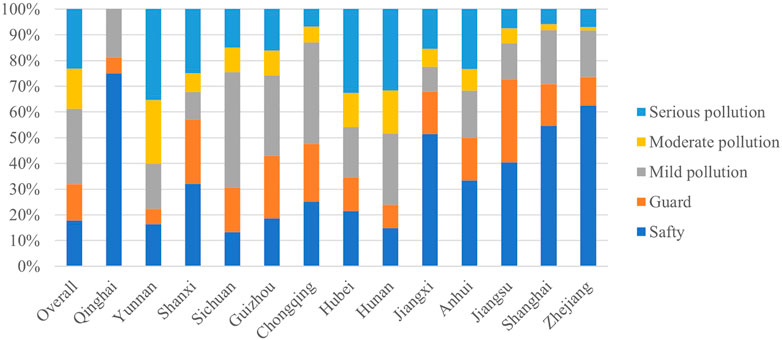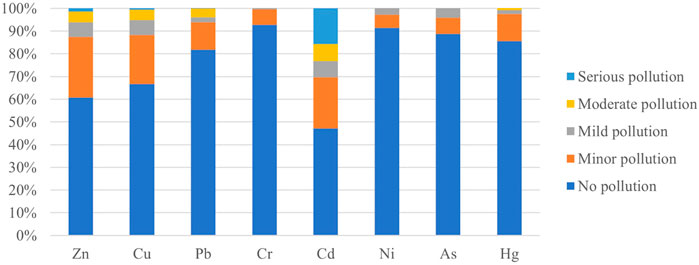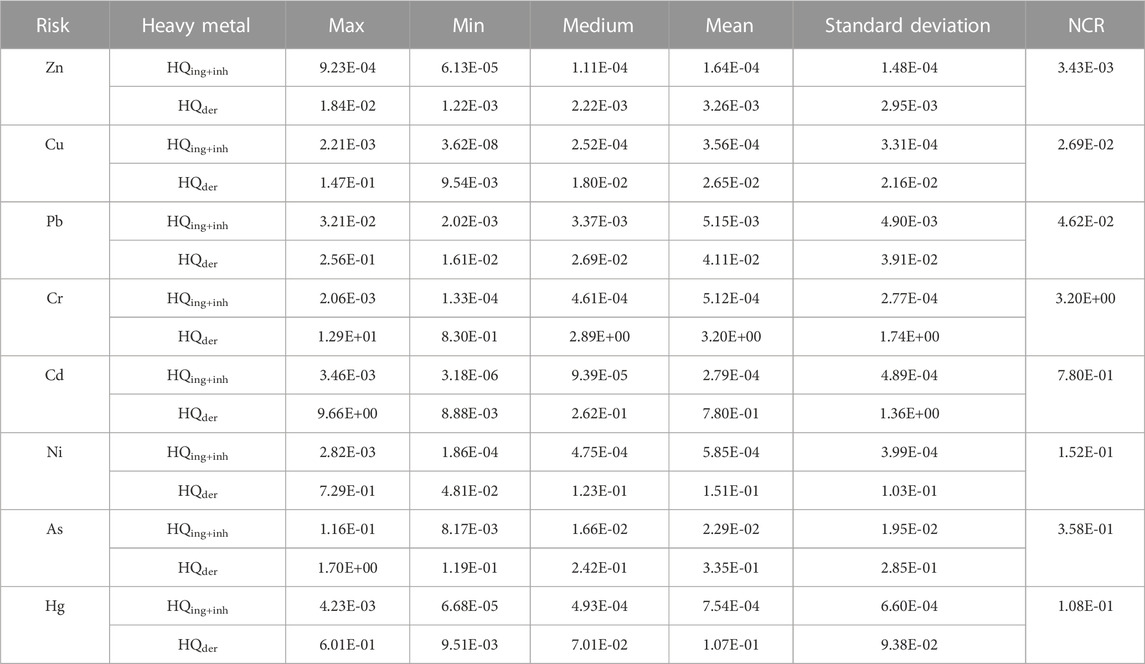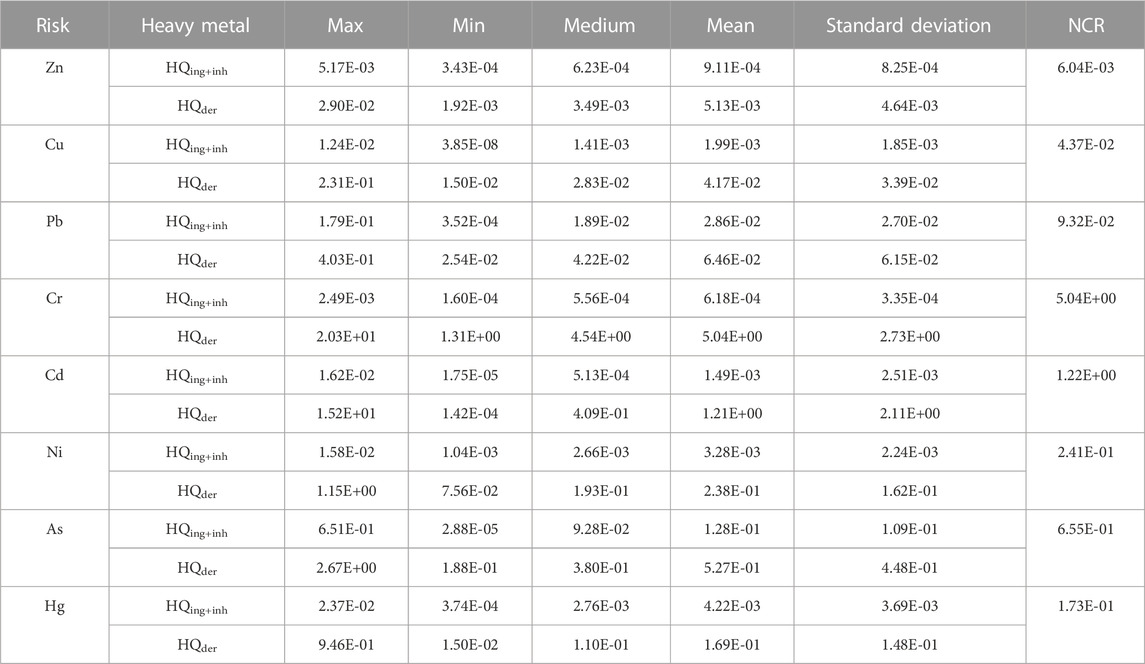- 1Yangtze Ecology and Environment Co., Ltd., Wuhan, China
- 2School of Environmental Science and Engineering, Huazhong University of Science and Technology, Wuhan, China
- 3Huadong Engineering Zhengzhou Corporation Limited Co., Ltd., Zhengzhou, China
- 4Yangtze Clean Energy Conservation and Environmental Protection Co., Ltd., Shanghai, China
Supporting ecological protection and restoration has been at the heart of China’s ambitious Yangtze River conservation strategy. Knowledge of the current status of heavy metal distribution is important for planning remediation practices and allocation to waste treatment facilities. Through an extensive and systematic review of literatures, this study depicts the up-to-date spatial distribution and characteristics of typical heavy metals in soils of the Yangtze River Basin, China. A total of 7,694 geo-referenced records of heavy metal in soils of the Yangtze River Basin were compiled from the literatures published between 2000 and 2020. The results show the spatially-heterogeneous concentrations of Zn, Cu, Pb, Cr, Ni, As, Hg and Cd. The degree of heavy metal pollution was relatively higher in the middle reaches, while it was relatively lower in the upstream and downstream. According to the limits set by the state to ensure agricultural production and maintain human health, the average concentration of Cd greatly exceeded its limit. Overall, a certain number of heavily polluted areas were found to occur in regions with frequent human economic activities, posing potential health risks. The carcinogenic and non-carcinogenic risks of children are 1.4 times and 1.6 times higher than those of adults, respectively, and the heavy metal with the highest risk to human health was Cr. This study provides an important basis for the field of soil pollution prevention and control in the Yangtze River Basin. It updates the current understanding of the spatial pattern of major pollutants in a large ecologically protected region in China, which is conducive to the precise prevention and control of public health risks.
1 Introduction
Heavy metals are defined as metals and metalloids with densities greater than 5 g/cm−3 (Jarup, 2003; Oves et al., 2012), mainly including zinc (Zn), copper (Cu), lead (Pb), cadmium (Cd), chromium (Cr), nickel (Ni), arsenic (As), mercury (Hg), etc., which are the major pollutants with the characteristics of difficult migration, long residual time, strong concealment and high toxicity (Cai et al., 2012; Yang et al., 2018). Heavy metals come from both natural and anthropogenic sources, of which anthropogenic sources have proven to be the main sources of heavy metals, including mineral resource exploitation, metal processing and smelting, chemical production, factory discharge, and sewage irrigation (Yang et al., 2018). Excessive accumulation of heavy metals in soils can lead to changes in soil composition, structure and function, which can inhibit crop growth and even reduce soil productivity (Cai et al., 2012; Wei et al., 2016). In addition, heavy metal pollution in soils can negatively affect human health, directly or indirectly, through the food chain (Zhang et al., 2012; Cai et al., 2019). For example, minamata disease (Hg pollution) and bone-pain disease (Cd pollution) in Japan were caused by heavy metal pollution (Jarup, 2003).
In the past few years, the central government has conducted several in-depth investigations in regions along the Yangtze River and held symposiums on promoting the development of the Yangtze River Economic Belt, emphasizing that the restoration of the ecological environment of the Yangtze River should be placed in an overwhelming position (Luo et al., 2021; Zhang et al., 2021). The Yangtze River Basin is rich in mineral resources, with mineral species accounting for 80% of the proven mineral species in China. With the rapid development of industry in the Yangtze River Basin, more than 400,000 chemical industries are distributed along the Yangtze River (Ye et al., 2019). Abundant mineral resources would lead to the increase of the background value of heavy metals in soils, and frequent exploitation of mineral resources and industrial activities would lead to the aggravation of heavy metal pollution in nearby soils. Meanwhile, the Yangtze River basin, accounting for 25% of the arable land and 29.1% of the grain output in 2015, is considered a major agricultural production base in China (Xu et al., 2019). Therefore, the spatial distribution, pollution degree and health risk assessment of heavy metals in soils of the Yangtze River Basin are directly related to human health and public wellbeing (Li et al., 2019; Mir et al., 2022), which have received extensive attention from scientific community.
However, at present, most of the studies on heavy metals in soils of the Yangtze River Basin were local and small scale (Yang et al., 2016; Chao et al., 2017; Ni et al., 2018; Yang et al., 2020; Luo et al., 2021; Ai et al., 2022) or a few common heavy metals (Wen et al., 2013; Zhou and Wang, 2019), and there is a lack of comprehensive and systematic studies on soils of the whole Yangtze River Basin. Jiang et al. (2022) studied the spatial distribution of heavy metals in soils and sediments of the Yangtze River Basin, but did not assess the health risk of heavy metals. At present, there are two important scientific issues that require to be resolved: 1) the spatial distribution of heavy metals in soils of the Yangtze River Basin has not been updated; 2) the health risk of heavy metals in soils of the Yangtze River Basin remain unclear.
In this study, we described the spatial distribution and concentration of heavy metals in soils of the Yangtze River Basin by systematically collecting and analysing peer-reviewed literatures from 2000 to 2020, considering the collectability of data, data reliability, research objectives and policy background. We analysed the degree of heavy metal pollution and assessed the health risk of heavy metals in the Yangtze River Basin. This method is highly empirical and practical for studying the spatial distribution of heavy metals in soil, because it makes full use of abundant peer-reviewed literatures in the past 20 years to provide a comprehensive and in-depth data base for our research. Our study fills a research gap in describing the spatial distribution and health risk assessment of major heavy metals in soils of the Yangtze River Basin. Our results could provide fundamental data support for the establishment of well-targeted heavy metal pollution prevention and control strategies, providing new insights into the distribution and potential health risks of soil heavy metals in China’s largest river basin.
2 Materials and methods
2.1 Study area
As the largest river in Asia, the Yangtze River is about 6,300 km long, originating in the Tanggula Mountains in Qinghai and entering the East China Sea in Shanghai. The main stream of the Yangtze River flows through 11 provinces (Qinghai, Xizang, Sichuan, Yunan, Chongqing, Hubei, Hunan, Jiangxi, Anhui, Jiangsu and Shanghai), and hundreds of tributaries flow through 8 provinces, including Guizhou, Gansu, Shanxi, Hunan, Guangxi, Guangdong, Zhejiang and Fujian (Figure 1).
2.2 An extensive review and records collection
The schematic overview of the literatures search procedure and results is showed in Figure 2. Since the boundary of the Yangtze River Basin is not clear, it is impossible to limit the scope of publications search through search formulas. Therefore, the spatial scale of data collection was the whole of China, the temporal scale was 2000–2020, the search objects were the information (concentration and location, etc.) of eight heavy metals in soils, including Zn, Cu, Pb, Cr, Cd, Ni, As and Hg, which were listed as priority pollutants by the US Environmental Protection Agency. Considering the wide coverage, strong academic type and high accessibility, the databases of Web of Science (WOS) and China National Knowledge Infrastructure (CNKI) were chosen to search the publications. The keywords used for searching were [(heavy metal OR metal element OR metallic element) AND (concentration OR level OR content OR contamination OR pollution OR spatial distribution) AND soil AND China] with WOS, and [(heavy metal + metal + metal element) * (content + level + concentration + distribution) * soil * China] with CNKI.
Firstly, titles and abstracts of publications were examined and we excluded publications which only described heavy metal resistant plants or heavy metal detection technology not measured heavy metal concentration, or which only focused on human or organism not selected environment matrices, or did not include any target heavy metals, or did not involve any geographic information. Secondly, having intensively read all the full-texts, the publications which failed to report details of occurrence data and geographical information were further excluded, and finally, 1935 publications (736 for WOS and 1,199 for CNKI) were identified to be eligible for extraction.
2.3 Georeferencing and data analytical steps
The key information extracted from the publications included sampling location, sampling time, analysis method, concentration of heavy metals. In line with the georeferencing strategy adopted previously (Zhang et al., 2022), the concentrations of heavy metal were processed as follows: 1) the concentration only extracted the total concentration of various heavy metals, ignoring the concentration data that only records one or more forms; 2) the concentration of heavy metals is uniformly converted into standard concentration units (mg/kg). The locations of the sampling points were processed as follows: 1) if the latitude and longitude of the sampling points were recorded in the publication, the latitude and longitude were extracted directly; 2) if the latitude and longitude of the sampling points were not recorded in the publication, we determined the latitudinal and longitudinal using Web APIs (Application Programming Interfaces) to access georeference functions of the most commonly used online location services in China, namely, Baidu Map and Amap. We searched keywords related to the location of each record, for example, the name of specific geographical objects, administrative regions, or water bodies, and recorded the latitude/longitude information. When only maps of the sampling points were provided, we approximated rough coordinates through visual interpretation, mapped these records on Baidu Map or Amap, and then adjusted the coordinates according to the geographical characteristics of the original maps. A total of 21,310 records involving the concentration and location of heavy metals were extracted, one of which contained related information for only one heavy metal, and then we clipped out the data under the Yangtze River Basin. There were 7,867 records of heavy metals in soils of the Yangtze River Basin (Zn: 1,045; Cu: 1,140; Pb: 1,261; Cr: 980; Cd: 1,242; Ni: 649; As: 821; Hg: 729).
We used the data in the X/4∼4X (X is the average concentration of each heavy metal) concentration range of each metal in the above records for further pollution degree and health risk accessment to exclude the influence of extremely high and low values of the measured concentrations in the original publication. After a simple processing of the data, a total of 5,381 records (Zn: 861; Cu: 947; Pb: 1,025; Cr: 912; Cd: 296; Ni: 594; As: 613; Hg: 133) were used to assess pollution degree and health risk in the Yangtze River Basin. Descriptive statistics, such as mean, median, minimum, maximum, standard deviation (SD), variation coefficient, kurtosis and skewness, were used to analyze heavy metals. The single factor index and Nemerow’s synthetic pollution index were used to estimate the pollution degree for heavy metals. Based on ArcGIS version 10.7, the spatial distribution of heavy metal pollution was visualized by using Inverse Distance Weight (IDW) and Spatial Autocorrelation.
2.4 Pollution index calculation
Single factor index and Nemerow’s synthetic pollution index were used to assess the degree of heavy metals pollution in soils (Gong et al., 2008). The calculation (Formula 1ormula –Formula 3) and grading standards (Supplementary Tables S1, S2) of single factor index and Nemerow’s synthetic pollution index of heavy metals were as follows (Gong et al., 2008; Chen et al., 2013; Chen et al., 2014; Islam et al., 2023):
(i) Single factor index
Where Pi is single factor index value of heavy metal i; Ci is the measured concentration of heavy metal i in soils (mg/kg); Si is the standard of soil environmental quality.
(ii) Nemerow’s synthetic pollution index
Where PI is Nemerow’s synthetic pollution index value of heavy metal; Wi is the weight of heavy metal i;
2.5 Health risk assessment
The carcinogenic risk (CR) and non-carcinogenic risk (NCR) indexes were used to assess the health risk of heavy metals in soils of the Yangtze River Basin to adults and children.
(i) Average daily intake (ADI):
The calculation formulas for the intake of the non-carcinogenic average daily exposure of the three pathways of human exposure to heavy metals were as follows:
Where
(ii) The carcinogenic risk (CR) and non-carcinogenic risk (NCR) indexes:
Where
3 Results and discussions
3.1 Occurrence and spatial distribution of heavy metals
The spatial distribution of sampling points of heavy metals in soils of the Yangtze River Basin is shown in Figure 3. The boxplots of heavy metal concentration are shown in Figure 4 and other descriptive statistics are shown Table 1. In these records, the sampling points were mostly located in the surface soil of 0–20 or 0–30 cm, the sampling time involved all months of the year, the treatments of the samples mainly included drying, crushing, digestion and analysis, in which HNO3–HClO4–HF or HNO3–HClO4–HCl or HCl–HNO3–HF–HClO4 were used for the digestion of mixed acids, and the analysis methods were mostly Atomic Absorption Spectroscopy (AAS) or Atomic Fluorescence Spectrometry (AFS) or Auger electron spectroscopy (AES) or Inductively coupled plasma mass spectrometry (ICP-MS).
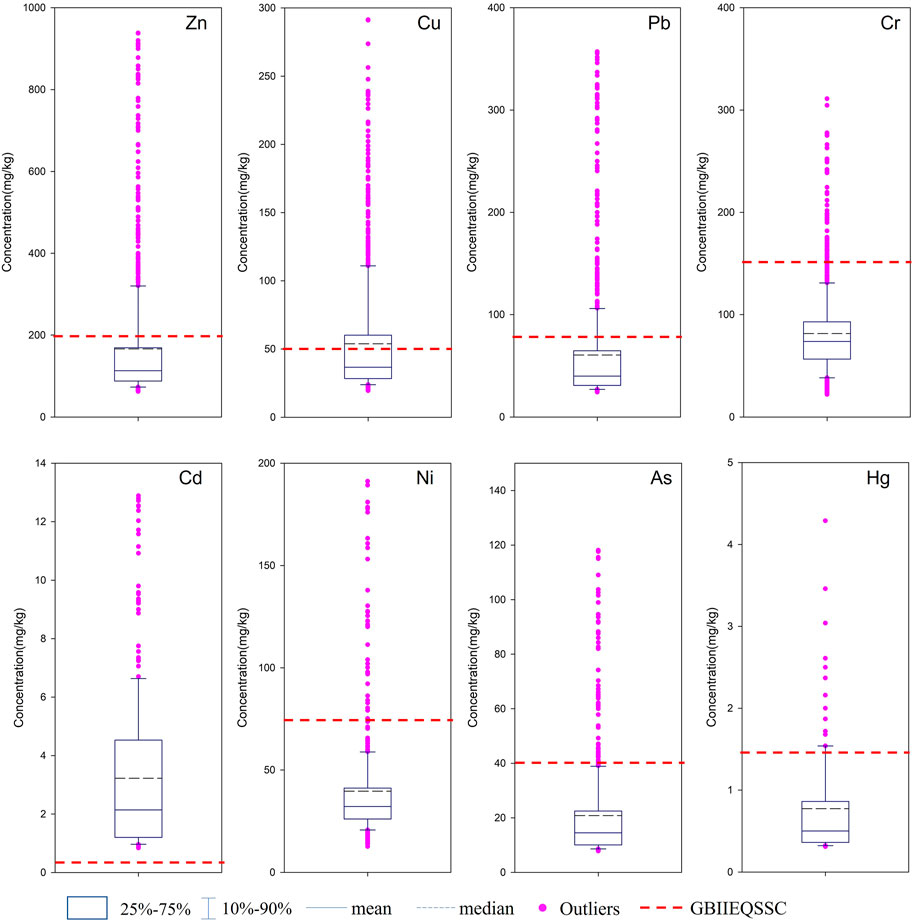
FIGURE 4. Boxplots of heavy metal concentration (mg/kg) in soils of the Yangtze River Basin (GBIIEQSSC: Secondary Standard for Soil Environmental Quality).
The distribution of heavy metal sampling points in soils was relatively uniform, and the concentration range of Zn, Cu, Pb, Cr, Cd, Ni, As and Hg was 63.0–893.0 mg/kg, 19.0–291.0 mg/kg, 24.0–331.0 mg/kg, 22.0–305.0 mg/kg, 0.8–12.6 mg/kg, 12.0–191.0 mg/kg, 7.84–116.0 mg/kg, 0.3–4.3 mg/kg, respectively. The average concentrations were 120.6, 41.2, 46.2, 82.0, 2.1, 30.7, 12.8 and 0.5 mg/kg, respectively. With China’s Secondary Standard for Soil Environmental Quality as the reference value (GB15618-2018), the average concentration of Zn, Cu, Pb, Cr, Ni, As and Hg were all lower than the reference values, while the average concentration of Cd was 7 times higher than the reference value. In terms of excess rate, all heavy metals had sampling points with excessive concentrations. Most of the sampling points of Cd and half of Cu had excessive concentration. The proportions of sampling points with excessive concentration of Zn, Pb, As, and Hg were less than 20%. The heavy metals with the lowest excess rate were Cr and Ni, which were 7.24% and 7.93%, respectively. The results showed that Cd had a strong tendency to enrich in soils. The variation coefficients of heavy metals were exceeded 50%, which was a strong variation, indicating that the concentrations of heavy metals in soils were not only affected by the local background value, but also by human activities. Kurtosis and skewness were mainly used to measure the steepness and asymmetry of heavy metal concentration distribution. With the exception of Cd, the heavy metals showed a certain degree of steep and positive shift. This may be related to the sampling points range, sampling depth, and the surrounding industrial layout.
Figure 5 shows the spatial distribution of heavy metal pollution in soils of the Yangtze River Basin using Inverse Distance Weight (IDW). It can be seen that the spatial distribution of Cu and Pb was similar to some extent, showing that the concentrations of Cu and Pb were higher in Yunnan, eastern Liangshan Yi Autonomous Prefecture of Sichuan, southern Anhui and southern Hunan, while were lower in Qinghai, Chongqing, central and western Hubei and central and southern Jiangxi. The high value regions of Zn, Cu and Pb were scattered, which may be due to the occurrence of mineral association. The high value regions of Cr, Cd and Ni were dispersed, showing non-point pollution, the pollution of which were mainly from industrial emissions, coal burning and agricultural activities (fertilizers and pesticides). The low value regions of Cd were concentrated in Chongqing and Guizhou, while the low value regions of Ni were distributed in southern Hunan and Jiangxi. The regions with high Hg concentration accounted for the lowest proportion and were distributed in Huaihua, Loudi and Anqing in Hunan, which was because Hg mines in Hunan were mainly distributed in Xiangxi. The spatial distribution of Zn, As and Pb in Hunan were consistent, showing higher in Yongzhou, Hengyang and Binzhou in the south and Loudi and Huaihua in the west. In general, the spatial distribution of heavy metals in soils of the Yangtze River Basin was obviously lumpy, which may be closely related to human activities such as industrial emission and traffic emissions.
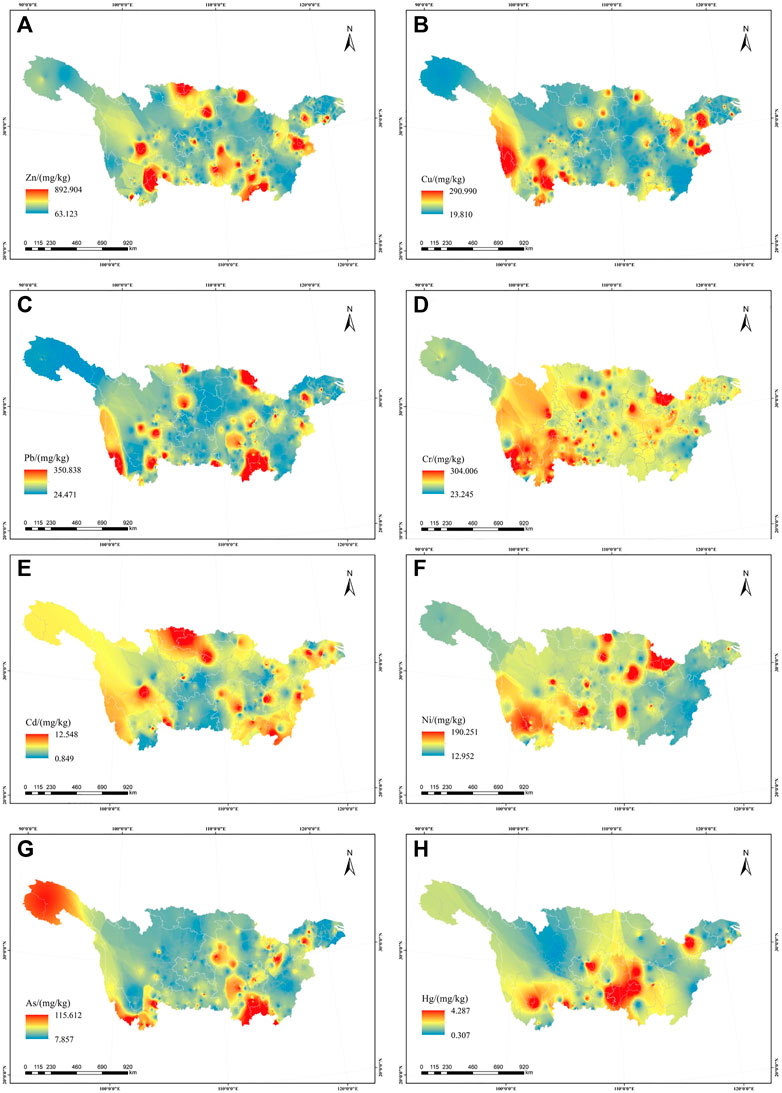
FIGURE 5. Spatial distribution of heavy metal pollution in soils of the Yangtze River Basin [(A): Zn; (B) Cu; (C) Pb; (D) Cr; (E) Cd; (F) Ni; (G) As; (H) Hg].
3.2 Degree of heavy metal pollution
Figure 6 depicts the spatial distribution of Nemerow’s synthetic pollution index of heavy metals in soils of the Yangtze River Basin, and it can be observed that the spatial distribution was uneven, with cities as the dividing point. The soils in the upper reaches of Yushu City and the lower reaches of Nanjing City were mainly clean, and that in the middle were mainly mild or moderate pollution. The serious pollution regions were distributed in plates, accounting for 23.19% of the Yangtze River Basin, mainly distributed in the western Sichuan, the border between Sichuan and Guizhou, the border between Sichuan and Yunnan, eastern Hubei, Hunan, Anhui. Crops and soils in the regions were more seriously polluted, and soil vulnerability was higher. The moderate pollution regions were mostly distributed on the periphery of the serious pollution regions, accounting for about 15.58% of the Yangtze River Basin. The mild pollution regions accounted for 29.25%, mainly distributed in the middle reaches of the Yangtze River, including central and eastern Sichuan, Chongqing, northern Hubei, southern Guizhou, southern Gansu and southern Shaanxi. Safety and guard regions were distributed in the upper reaches and Jiangxi, where the soils were in clean state. In short, the proportion of polluted soil in the Yangtze River Basin was 68.01%, while the proportion of clean soil was only about 30%, indicating that the soil in the Yangtze River Basin was seriously polluted by heavy metals.
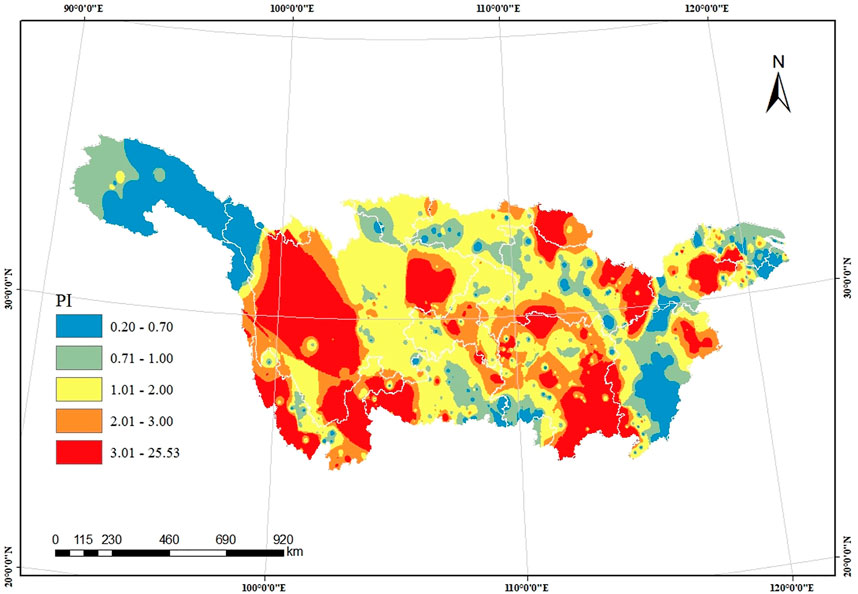
FIGURE 6. Distribution of Nemerow’s synthetic pollution index of heavy metals in soil in the Yangtze River Basin.
Figure 7 shows the percentage of heavy metal pollution degree for each province in the Yangtze River Basin. It can be observed that the proportions of serious pollution regions in Yunnan, Hunan and Hubei reached 35.29%, 31.67% and 32.64%, which were higher than the average level of the whole basin, which were related to their rich mineral resources and active human industrial activities. Yunnan is known as the kingdom of non-ferrous metals, with the largest reserves of Zn and Cd and the third largest reserves of Cu and Ni in China. Hunan is known as the hometown of non-ferrous metals, with Pb reserves ranking the third, Zn and Hg reserves ranking the top five in China. Huangshi, as a traditional mining city, has the largest mineral resource in Hubei. Human activities such as mineral development, smelting, and waste residue treatment have discharged a large amount of heavy metals. The safety and guard regions in Qinghai, Jiangxi and Shanghai accounted for more than 50%, Jiangsu was 40.16%, Shaanxi and Anhui were 32.14% and 33.33%, and the proportion of clean soil in other provinces was less than 30%. It can be seen that the degree of soil pollution varied greatly in different provinces, and there was a certain relationship between the spatial distribution of polluted region and mineral resources.
Figure 8 shows the percentage of pollution degree for each heavy metal in the Yangtze River Basin. The overall pollution degree of the eight typical heavy metals was Cd > Zn > Cu > Pb > Hg ∼ As ∼ Ni ∼ Cr. The proportion of sampling points with serious pollution for Cd accounted for 15.63% of all sampling points, and Zn, Cu and Pb were 1.40%, 0.53% and 0.10%, respectively. The proportion of sampling points with Cd concentration above the secondary standard value of soil environmental quality accounted for 50%. Therefore, Cd pollution in soils of the Yangtze River Basin was relatively serious.
3.3 Health risk assessment of heavy metal
3.3.1 The assessment of carcinogenic risk (CR)
Supplementary Figure S1 shows the distribution of carcinogenic risk in the Yangtze River Basin using Inverse Distance Weight. Then, the distribution of carcinogenic risk in the Yangtze River Basin at the district or county level using Zonal Statistics was showed in Figure 9. It can be seen that the carcinogenic risks for adults and children were mainly low or medium, of which the low carcinogenic risk for adults was 99.73% and that for children was 97.89%. The regions with moderate carcinogenic risk for adults were mainly distributed in Gucheng District, Ninglang Yi and Yulong Naxi Autonomous County in Lijiang City, Yunnan Province (the carcinogenic risk of Cd was high through dermal absorption), Wuding, Yuanmou and Yao’an County in Chuxiong Yi Autonomous Prefecture (the carcinogenic risk of Cd and Cr was high through dermal absorption), Yanbian and Miyi County in Panzhihua City, Sichuan Province (the carcinogenic risk of Cd was high through dermal absorption), accounting for 0.27% of the total river basin. The moderate risk regions for children included the moderate risk regions for adults and its peripheral regions, accounting for 2.11% of the total basin. The reasons for the larger area of the carcinogenic risk for children are the lower average body weight (BW), lower carcinogenic dose, higher soil ingestion rate (IRing), higher adherence factor (AF), etc.
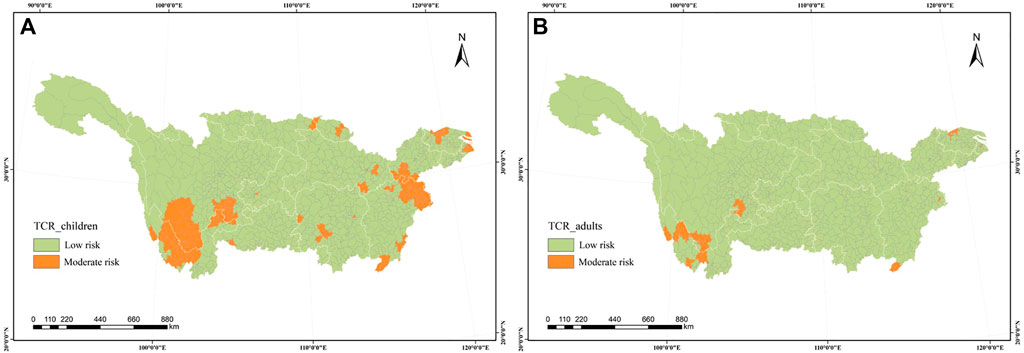
FIGURE 9. Distribution of soil carcinogenic risk of heavy metals at the district or county level in the Yangtze River Basin for (A) adults and (B) children.
The carcinogenic risk of Pb, Cr, Cd and As in soils of the Yangtze River Basin for adults and children are shown in Table 2. Figure 10 shows the contribution of various heavy metals to carcinogenic risk. The total carcinogenic risk for children (3.51 × 10−5) was higher than that for adults (2.42 × 10−5), and children were 1.45 times that of adults. However, the carcinogenic risk of soil heavy metals was lower than 10−4, the carcinogenic risk of soil heavy metals to human health was within an acceptable range. The carcinogenic risk of heavy metals for adults and children was Cr > As > Cd > Pb. The contribution rate of Cr for adults and children was the highest, reaching 51.33% and 48.97%, followed by As (31.51% and 34.73%) and Cd (16.93% and 16.09%), while the contribution rate of Pb was less than 0.5%.
3.3.2 The assessment of non-carcinogenic risk (NCR)
Tables 3, 4 shows the non-carcinogenic risk of soil heavy metals in the Yangtze River Basin for adults and children, respectively. It can be found that for adults, the non-carcinogenic risk was manifested as HQder > HQing+inh, of which the non-carcinogenic risk through dermal absorption of Pb was 7.98 times that of ingestion and inhalation, the others were more than 10 times, and Cd and Cr reached more than 1,000 times. For children, the non-carcinogenic risk through dermal absorption was also greater. The non-carcinogenic risk through dermal absorption of Pb was 2.26 times that of ingestion and inhalation, followed by As and Zn, and other heavy metals were more than 10 times. The non-carcinogenic risk through ingestion and inhalation were As > Pb > Hg > Ni > Cr > Cu > Cd > Zn. The non-carcinogenic risk through dermal absorption showed the different trend: Cr > Cd > As > Ni > Hg > Pb > Cu > Zn. For adults, the non-carcinogenic risk of Cr was greater than 1, and that of other heavy metals was less than 1, indicating that Cr had obvious non-carcinogenic risk for adults, and Cd and As in some sampling points had significant non-carcinogenic risk. The non-carcinogenic risk for children was generally higher than for adults. The non-carcinogenic risk of Cr and Cd for children was greater than 1, indicating that Cr and Cd had significant non-carcinogenic risk for children and were exposed through dermal absorption. In addition, the maximum value of non-carcinogenic risk of Ni and As was greater than 1, indicating that Ni and As in some sampling points had significant non-carcinogenic risks, and other heavy metals had no significant non-carcinogenic risks.
3.4 Prospect
This study shows the spatial distribution of heavy metals in the soil of the Yangtze River Basin and assesses the health risks. However, the collected soil heavy metal data may differ in sampling methods, sample size and analysis methods. The Yangtze River Basin is large and diverse, and the concentration of heavy metals in soil varies significantly depending on soil type, land use, agricultural activities and industrial activities. This study may not capture the full extent of this variability. Therefore, in order to better understand the impact mechanism of heavy metal pollution in the Yangtze River Basin, more research needs to be conducted.
4 Conclusion
In conclusion, this paper depicted the spatial distribution pattern of typical heavy metals in soil of the Yangtze River Basin, evaluated the degree of heavy metal pollution and human health risks, and provided reference for the decision-making of heavy metal pollution control over the region. The results showed that the spatial distribution of heavy metal in soil of the Yangtze River Basin was highly heterogenous. The spatial distribution of Cu and Pb had a certain similarity, the high-value area of Zn was relatively scattered, and the high-value areas of Cr, Cd and Ni were distributed in blocks. The degree of heavy metal pollution in soil of the Yangtze River Basin was low in the east-west and high in the middle. The degree of heavy metal in soil was mainly mild pollution, and the distribution of seriously polluted regions were in blocks, accounting for 23.19% of the total basin. The seriously polluted regions were mainly distributed in the western Sichuan, northern Yunnan, southern Hunan, southern Anhui, which were inseparable from local industrial activities such as mining and smelting, chemical plant production, and human activities such as agricultural production and automobile emissions. The carcinogenic risk of heavy metals was used to measure human health risk, and it was found that the carcinogenic risk for children was about 1.45 times that for adults. The risk areas were mainly distributed in the junction of Yunnan and Sichuan and northern Jiangxi, and the main carcinogenic heavy metal was Cr. From the perspective of the non-carcinogenic risk of heavy metals, dermal absorption was the main exposure pathway, Cr had remarkable non-carcinogenic risk for adults, and Cr and Cd have remarkable non-carcinogenic risks for children. The results have important guiding significance for the control of heavy metal pollution in the Yangtze River Basin.
Data availability statement
The original contributions presented in the study are included in the article/Supplementary Material, further inquiries can be directed to the corresponding authors.
Author contributions
SL, DL, and YS contributed to conception and design of the study. DL organized the database. DL and YS performed the statistical analysis. YS wrote the first draft of the manuscript. All authors contributed to manuscript revision, read, and approved the submitted version.
Funding
This work was supported by the National Key R&D Program of China (2020YFC1908705).
Conflict of interest
Authors YS, XZ, and WnC were employed by Yangtze Ecology and Environment Co., Ltd., Author DL was employed by Huadong Engineering Zhengzhou Corporation Limited Co., Ltd. and Authors YW, XH, YL, and WiC were employed by Yangtze Clean Energy Conservation and Environmental Protection Co., Ltd.
The remaining author declares that the research was conducted in the absence of any commercial or financial relationships that could be construed as a potential conflict of interest.
Publisher’s note
All claims expressed in this article are solely those of the authors and do not necessarily represent those of their affiliated organizations, or those of the publisher, the editors and the reviewers. Any product that may be evaluated in this article, or claim that may be made by its manufacturer, is not guaranteed or endorsed by the publisher.
Supplementary material
The Supplementary Material for this article can be found online at: https://www.frontiersin.org/articles/10.3389/fenvs.2023.1197634/full#supplementary-material
References
Ai, L., Ma, B., Shao, S., Zhang, L., and Zhang, L. (2022). Heavy metals in Chinese freshwater fish: Levels, regional distribution, sources and health risk assessment. Sci. Total Environ. 853, 158455. doi:10.1016/j.scitotenv.2022.158455
Cai, L.-M., Wang, Q.-S., Luo, J., Chen, L.-G., Zhu, R.-L., Wang, S., et al. (2019). Heavy metal contamination and health risk assessment for children near a large Cu-smelter in central China. Sci. Total Environ. 650, 725–733. doi:10.1016/j.scitotenv.2018.09.081
Cai, L., Xu, Z., Ren, M., Guo, Q., Hu, X., Hu, G., et al. (2012). Source identification of eight hazardous heavy metals in agricultural soils of Huizhou, Guangdong Province, China. Ecotox. Environ. Safe. 78, 2–8. doi:10.1016/j.ecoenv.2011.07.004
Chao, X., Peijiang, Z., Haiyan, L., and Huanhuan, W. (2017). Contamination and spatial distribution of heavy metals in soil of Xiangxi River water-level-fluctuating zone of the Three Gorges Reservoir, China. Hum. Ecol. Risk Assess. An Int. J. 23, 851–863. doi:10.1080/10807039.2017.1288562
Chen, H., Lu, X., Chang, Y., and Xue, W. (2014). Heavy metal contamination in dust from kindergartens and elementary schools in Xi’an, China. Environ. Earth Sci. 71, 2701–2709. doi:10.1007/s12665-013-2648-9
Chen, X., Lu, X., Li, L. Y., and Yang, G. (2013). Spatial distribution and contamination assessment of heavy metals in urban topsoil from inside the Xi’an second ringroad, NW China. Environ. Earth Sci. 68, 1979–1988. doi:10.1007/s12665-012-1885-7
Gong, Q., Deng, J., Xiang, Y., Wang, Q., and Yang, L. (2008). Calculating pollution indices by heavy metals in ecological geochemistry assessment and a case study in parks of Beijing. J. China Univ. Geosciences 19, 230–241. doi:10.1016/S1002-0705(08)60042-4
HC (2004). Federal contaminated site risk assessment in Canada-Part II: HealthCanada toxicological reference values (TRVs) and chemical-specific factors.
Islam, A. R. M. T., Varol, M., Habib, M. A., and Khan, R. (2023). Risk assessment and source apportionment for metals in sediments of Kaptai Lake in Bangladesh using individual and synergistic indices and a receptor model. Mar. Pollut. Bull. 190, 114845. doi:10.1016/j.marpolbul.2023.114845
Jarup, L. (2003). Hazards of heavy metal contamination. Br. Med. Bull. 68, 167–182. doi:10.1093/bmb/ldg032
Jiang, Y., Chao, S., Liu, J., Yang, Y., Chen, Y., Zhang, A., et al. (2017). Source apportionment and health risk assessment of heavy metals in soil for a township in Jiangsu Province, China. Chemosphere 168, 1658–1668. doi:10.1016/j.chemosphere.2016.11.088
Jiang, Y., Guo, Q.-J., Deng, Y.-N., Lu, W. J., Ma, S., Chang, Y., et al. (2022). Ranolazine rescues the heart failure phenotype of PLN-deficient human pluripotent stem cell-derived cardiomyocytes. Chin. J. Ecol. 41, 804–819. doi:10.1016/j.stemcr.2022.02.016
Li, C., Zhou, K., Qin, W., Tian, C., Qi, M., Yan, X., et al. (2019). A review on heavy metals contamination in soil: Effects, sources, and remediation techniques. Soil Sediment Contam. An Int. J. 28 (4), 380–394. doi:10.1080/15320383.2019.1592108
Luo, M., Yu, H., Liu, Q., Lan, W., Ye, Q., Niu, Y., et al. (2021). Effect of river-lake connectivity on heavy metal diffusion and source identification of heavy metals in the middle and lower reaches of the Yangtze River. J. Hazard. Mate. 416, 125818. doi:10.1016/j.jhazmat.2021.125818
Mir, I. A., SreePrabash, M., Sridhar, V., and Maruthi, K. V. (2022). Distribution, sources and toxicity of heavy metals in surface sediments of north Western Karnataka, south India. Sci. Rep. 12 (1), 15782. doi:10.1038/s41598-022-19672-w
Ni, M., Mao, R., Jia, Z., Dong, R., and Li, S. (2018). Heavy metals in soils of Hechuan County in the upper Yangtze (SW China): Comparative pollution assessment using multiple indices with high-spatial-resolution sampling. Ecotox. Environ. Safe. 148, 644–651. doi:10.1016/j.ecoenv.2017.11.009
Oves, M., Khan, M. S., Zaidi, A., and Ahmad, E. (2012). Soil contamination, nutritive value, and human health risk assessment of heavy metals: An overview. Vienna: Springer, 1–27.
UEPA (2011). Exposure factors handbook 2011 edition (final). Washington, DC: US Environmental Protection Agency. EPA/600/R-09.
U. S. DoE (2011). The risk assessment information system (RAIS). Argonne, IL: US Department of Energy’s Oak Ridge Operations Office.
USEPA (2001). Risk assessment guidance for superfund: Volume III part A, process for conducting probabilistic risk assessment. Washington, DC: US Environmental Protection Agency.
Varol, M., Sünbül, M. R., Aytop, H., and Yılmaz, C. H. (2020). Environmental, ecological and health risks of trace elements, and their sources in soils of Harran Plain, Turkey. Chemosphere 245, 125592. doi:10.1016/j.chemosphere.2019.125592
Varol, M., and Sünbül, M. R. (2020). Macroelements and toxic trace elements in muscle and liver of fish species from the largest three reservoirs in Turkey and human risk assessment based on the worst-case scenarios. Environ. Res. 184, 109298. doi:10.1016/j.envres.2020.109298
Wei, L., Wang, K., Noguera, D. R., Jiang, J., Oyserman, B., Zhao, N., et al. (2016). Transformation and speciation of typical heavy metals in soil aquifer treatment system during long time recharging with secondary effluent: Depth distribution and combination. Chemosphere 165, 100–109. doi:10.1016/j.chemosphere.2016.09.027
Wen, Y., Yang, Z., and Xia, X. (2013). Dissolved and particulate zinc and nickel in the Yangtze River (China): Distribution, sources and fluxes. Appl. Geochem. 31, 199–208. doi:10.1016/j.apgeochem.2013.01.004
Xu, X., Hu, H., Tan, Y., Yang, G., Zhu, P., and Jiang, B. (2019). Quantifying the impacts of climate variability and human interventions on crop production and food security in the Yangtze River Basin, China, 1990–2015. Sci. Total Environ. 665, 379–389. doi:10.1016/j.scitotenv.2019.02.118
Yang, B., Zhang, C., Zhang, X., Wang, G., Li, L., Geng, H., et al. (2020). Survey of aflatoxin B1 and heavy metal contamination in peanut and peanut soil in China during 2017–2018. Food Control. 118, 107372. doi:10.1016/j.foodcont.2020.107372
Yang, F., Hao, Z., Zhang, S., Liu, H., Wang, C., and Ling, Q. (2016). Environment geochemistry of heavy metals in the alluvial soils of Yangtze River in Wuhan City. Acta Geologica Sinica 90 (8), 1955–1964.
Yang, Q., Li, Z., Lu, X., Duan, Q., Huang, L., and Bi, J. (2018). A review of soil heavy metal pollution from industrial and agricultural regions in China: Pollution and risk assessment. Sci. Total Environ. 642, 690–700. doi:10.1016/j.scitotenv.2018.06.068
Ye, C., Butler, O. M., Du, M., Liu, W., and Zhang, Q. (2019). Spatio-temporal dynamics, drivers and potential sources of heavy metal pollution in riparian soils along a 600 kilometre stream gradient in Central China. Sci. Total Environ. 651, 1935–1945. doi:10.1016/j.scitotenv.2018.10.107
Zhang, Q., Zhang, G., Liu, D., Zhang, X., Fang, R., Wang, L., et al. (2022). A dataset of distribution of antibiotic occurrence in solid environmental matrices in China. Sci. Data 9, 276. doi:10.1038/s41597-022-01384-5
Zhang, X., Yang, L., Li, Y., Li, H., Wang, W., and Ye, B. (2012). Impacts of lead/zinc mining and smelting on the environment and human health in China. Environ. Monit. Assess. 184, 2261–2273. doi:10.1007/s10661-011-2115-6
Zhang, Y., Sun, M., Yang, R., Li, X., Zhang, L., and Li, M. (2021). Decoupling water environment pressures from economic growth in the Yangtze River Economic Belt, China. Ecol. Indic. 122, 107314. doi:10.1016/j.ecolind.2020.107314
Keywords: spatial distribution, heavy metal, health risk, soil, the Yangtze River Basin
Citation: Sun Y, Liu D, Wu Y, He X, Luo Y, Zhou X, Chen W, Chen W and Li S (2023) Updated spatial distribution and health risk assessment of heavy metals in soils of the Yangtze River Basin, China. Front. Environ. Sci. 11:1197634. doi: 10.3389/fenvs.2023.1197634
Received: 31 March 2023; Accepted: 25 April 2023;
Published: 09 May 2023.
Edited by:
Zhenming Zhang, Guizhou University, ChinaReviewed by:
Jinyao Lin, Guangzhou University, ChinaQu Rui, China Three Gorges University, China
Memet Varol, Malatya Turgut Özal University, Türkiye
Copyright © 2023 Sun, Liu, Wu, He, Luo, Zhou, Chen, Chen and Li. This is an open-access article distributed under the terms of the Creative Commons Attribution License (CC BY). The use, distribution or reproduction in other forums is permitted, provided the original author(s) and the copyright owner(s) are credited and that the original publication in this journal is cited, in accordance with accepted academic practice. No use, distribution or reproduction is permitted which does not comply with these terms.
*Correspondence: Wei Chen, Y2hlbl93ZWkyN0BjdGcuY29tLmNu; Sen Li, c2VubGlAaHVzdC5lZHUuY24=
†These authors have contributed equally to this work
 Yifan Sun
Yifan Sun Dongsheng Liu3†
Dongsheng Liu3† Sen Li
Sen Li